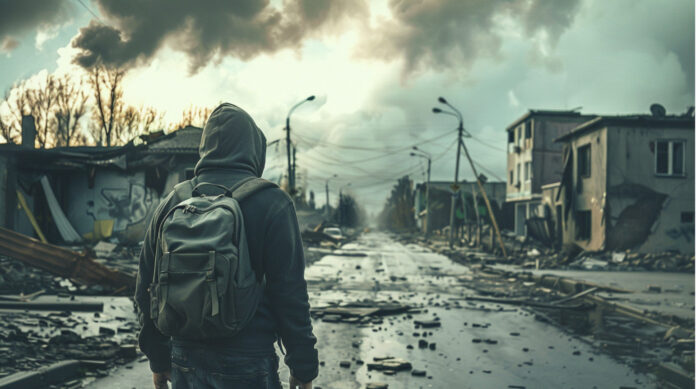
This is part one of a two-part post on bugging out. It does not address how to determine when to bug out because everyone’s situation is difference. Instead, it focusses on how to bug out. Part two will go into greater depth on food for bugging out, especially when you are forced to walk to your destination.
Bugging Out
If you are a prepper, one of the first things you should do is create a bugout plan and a bugout bag for yourself and everyone in your family. You may also want to create a get-home bag to carry supplies you might need if you were forced to walk home from work or wherever you are when the SHTF.
But there is more to bugging out or getting home than just the bag. You need to know where you are going and how to get there. In other words, you need a plan and a course of action. You need to coordinate with whoever is at the destination of your bugout, so they expect you. Most importantly, you need to survive the trip.
You may hate the idea of bugging out and leaving everything behind. I don’t blame you, but there are times when you may not have a choice. We have never had do, and we don’t want to, but we still prepared to do so.
As we moved about the country over the past 30 years, we have had two bugout locations. One was close, just 17 miles. The other was a four-hour drive. We made plans to drive to each, but we had fallback plans to walk.
Leave Early
The single most important ingredient to an easy bugout is to leave early enough you are already at your destination when the SHTF.
Unless you are going over the hill to a neighbor’s house, or somewhere else just a few miles away, walking to your bugout location should be your last resort. This is why I recommend you bug out or evacuate before the disaster hits while you can still drive. A trip that might take six hours in a car could turn into a four-week walk. If you are escaping a hurricane or other local event, departing early will ensure you can refill your gas tank while underway and get a decent hotel room at your destination. Evacuating in style to a hotel room sure beats sleeping on a cot in the Nation Guard Armory or the high school gym, but it has limited value in an end-of-the-world crisis. It is best to have a destination in mind where people and supplies await your arrival.
Of course, leaving early that only works if you know the event is coming, and while we can predict weather-related events, many disasters are a surprise. If things go so bad that you cannot drive, then walking may be your best bet.
Right now, all of you with kids, pets, or others unable to walk even five miles are shaking your heads. Yeah, I get it. I had three kids and getting a two-year old to hike can be a non-starter. There is no easy solution other than 1) living somewhere you can bug in or 2) bugging out early enough that you can drive.
Bugging Out on Foot
Whether you are going 30 miles, 130 miles, or 300, I believe it is to your advantage you to get there as fast as possible, even if you are forced to walk. So don’t dawdle. This is not a nature walk, it is a march and your survival depends on getting to the safety of your destination as soon as possible. I would suggest starting at 12 miles per day and working up to 18 as you build stamina and your pack gets lighter as you consume your food. If your physical abilities and terrain allow you to do 20 or 25 miles per day, more power to you.
Depending on the scenario and the timing, and whether the rule of law still exists, you may need to avoid cities and towns, which will add to your travel time. You may be able to walk along roads, or you may have to stay off them. You may choose to travel at night, hoping to avoid trouble, and lay low during the day.
During your bugout on foot, don’t set up an elaborate camp, don’t light fires unless you need one to stay warm, and try not to leave a trail others can follow. Even in camp, keep packed and be ready to move if you have to. Running from a conflict or a dangerous encounter may save your life. Fighting back, even if you are heavily armed, should be a last resort because the gunfire may draw others.
Mapping Your Route
Back in 2013, we had plans to bug out to a farm 17 miles from our home. I used the color printer at work to print out Google maps with the satellite view for every step of the way. I noted where there were rivers and stream we would need to cross (there was a big river) and the best places to do that. Most importantly, I found high-tension wire right-of-ways that we could use to cover two-thirds of the distance.
Once I identified the route, I drove it (or close to it as possible) and noted where we could cross roads with the least chance of being seen. Next, I walked as much of it as I could without walking through people’s back yards or blatantly trespassing. This meant walking it in disjointed sections, but doing so was especially useful because I found there was a large marshy area in one of the power-line cuts. We would want to avoid that. The document, marked with routes and alternate routes, went into my bugout bag.
This is the kind of route planning you should do, even if you have to cover 130 miles instead of 17. Study maps and satellite photography, drive it and look for problems or opportunities. Where can you get water? Are there places you can find shelter to spend the night? Which bridges should you avoid, or where can you cross a body of water without a bridge? Are there railroad tracks, power-line cuts or other features you can take by foot that you could not use if driving?
Even if you can bugout via car, it is good to have hard copy maps and to know alternate routes, including those that do not use the interstates. If there are travel restrictions or martial law, you may be better off avoiding the main roads and taking rural routes, farm roads, and other back roads. It’s better still to have driven them and know your way around before the SHTF.
Weight Limitations
You can only carry so much, so focus on things that will keep you alive, not necessarily comfortable. Chief among those is a water filter, water purification tablets, and food. The big three (food, water and shelter) are critical to survival even when bugging out.
On a hike of more than three days, you will be hungriest during the first few days and then your body should begin to adapt. If you are going more than 30 miles, expect to lose weight and be hungry, weary, dirty, and fairly miserable when you get there. But the key is that you got there.
If there is a likelihood of you will have to hike many miles, I recommend you read the accounts of through hikers, those that hike from Maine to Georgia, or vice versa, on the Appalachian Trail. Also, check out how hobos carried and what frontiersmen used. You can find useful videos on YouTube covering these topics. Most important, practice to improve your physical stamina and test your gear. The time to find your boots are giving you blisters and your pack is uncomfortable is well before you have left your home behind for good.
Finally, remember that an army marches on its stomach, and so will you. Pack as much food as you can reasonably carry. Part two, which will be posted next week, includes more on food for bugging out, including tips and suggestions on maximizing your food load out.






